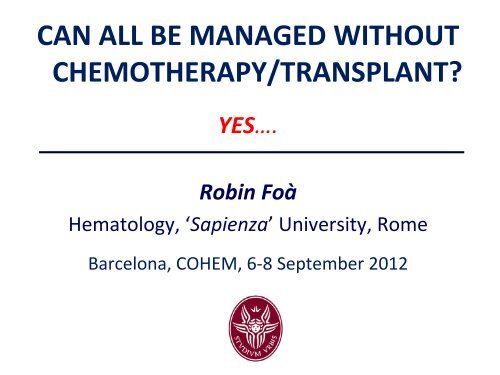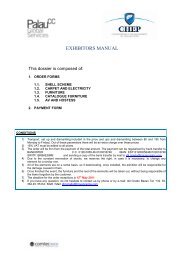Cellule staminali: dal laboratorio alla clinica - Comtecmed.com
Cellule staminali: dal laboratorio alla clinica - Comtecmed.com
Cellule staminali: dal laboratorio alla clinica - Comtecmed.com
You also want an ePaper? Increase the reach of your titles
YUMPU automatically turns print PDFs into web optimized ePapers that Google loves.
CAN ALL BE MANAGED WITHOUT<br />
CHEMOTHERAPY/TRANSPLANT?<br />
YES….<br />
Robin Foà<br />
Hematology, ‘Sapienza’University, Rome<br />
Barcelona, COHEM, 6‐8 September 2012
GIMEMA: DFS According to Cytogenetic-<br />
p
Enrolled: 45 patients<br />
Evaluable: 37 patients<br />
Imatinib in Adult Ph+ ALL:<br />
GIMEMA LAL 0201B Study<br />
Median age 68; range 61 – 89<br />
Hematologic CR 100%<br />
Vignetti et al. Blood 2007;109:3676–3678
GIMEMA LAL1205 Protocol<br />
Dasatinib<br />
Dasatinib 70 mg twice a day (total planned treatment is 12<br />
weeks, i.e. 84 days)<br />
Diagnostic work-up (within 7 d) and immunophenotypic &<br />
molecular monitoring of MRD carried out centrally in Rome
GIMEMA LAL 1205 (Ph+ ALL)<br />
55 patients enrolled<br />
53 patients evaluable. Median age 53.6 years<br />
(range 23.8‐76.5)<br />
WBC (median) 18.8/mm 3<br />
(range 2.2‐132.9)<br />
33 p190, 20 p210<br />
100% CHR<br />
49 CHR (92.5%) already by day +22<br />
No fatalities<br />
OS at 20 months 69.2% (median 30.8 months)<br />
DFS at 20 months 51.1% (median 21.1 months)<br />
Foà et al. ASH, EHA & BLOOD 2011
A 91 YEAR OLD ALL PATIENT…<br />
PC, diagnosed with Ph+ ALL in<br />
September 2007 at the age of<br />
89. Treated with Imatinib alone<br />
(partly at home…). Obtained a<br />
CHR, MRD-, and turned 90...<br />
Drived a car and occasionally<br />
helped in the family garage…<br />
Relapse in June 2009. II nd CR<br />
with Dasatinib. Relapse in<br />
February 2010, responded to<br />
VCR. Died March of heart failure,<br />
at 91, 2½ years from diagnosis.<br />
Courtesy of Prof. G. Pizzolo
GIMEMA LAL 0201‐B<br />
Overall survival<br />
N: 39 – events: 19<br />
Vignetti et al. Blood 2007;109:3676–3678
Age‐Specific Annual Incidence of ALL<br />
(US‐SEER Data, 1998–2002)<br />
Larson RA. Acute Lymphoblastic Leukemia: Older Patients and<br />
Newer Drugs. Hematology 2005:131‐136.
Incidence of molecular aberrations<br />
within B‐ALL (GIMEMA‐AIEOP data)<br />
GIMEMA LAL 2000: BCR/ABL+ 27.7%<br />
Affymetrix normalized values<br />
56007<br />
T‐ALL and ABL rearrangements<br />
43006<br />
19008<br />
12008<br />
H 2 O<br />
Nup214<br />
ABL1<br />
ABL1<br />
ABL1<br />
Chiaretti et al, Haematologica 2007
331 genes<br />
GENE EXPRESSION PROFILE OF PRE‐B ALL<br />
gain 1q and gain1q23<br />
ALL1/AF4 has a unique gene expression<br />
profile, that is <strong>com</strong>parable in children and in<br />
adults. Overexpression of Flt3, HOXA5 and<br />
HOXA9.<br />
E2A/PBX is also characterized by a strong<br />
signature. Most overexpressed genes: PBX1,<br />
NID2, FAT and several tyrosine kinases. Gain<br />
of 1q behave like E2A/PBX+ samples.<br />
BCR/ABL has a profile characterized by<br />
overexpression of several tyrosine kinases<br />
and cell cycle related genes. More<br />
heterogeneous profile.<br />
No clear pattern is observed for samples<br />
without molecular abnormalities.<br />
Chiaretti et al, Clin Cancer Res, 2005
Ph‐LIKE CASES FOUND BOTH IN CHILDOOD<br />
AND ADULT ALL BEING BCR‐ABL1<br />
NEGATIVE<br />
• Significantly inferior to out<strong>com</strong>e <strong>com</strong>pared to that of<br />
non‐BCR‐ABL1‐like cases.<br />
• Novel chromosomal rearrangements and sequence<br />
mutations found in high‐risk Ph‐like ALL.<br />
These data support the screening at diagnosis to identify<br />
Ph‐like ALL cases, characterize the genomic lesions<br />
driving this phenotype and determine those that may<br />
benefit from TKI treatment.
Bispecific anti‐CD19/anti‐CD3<br />
• Blinatumomab (MT‐103), BiTE<br />
• A bispecific single‐chain antibody derivative<br />
designed to link B cells and T cells resulting in T‐<br />
cell activation and a cytotoxic T‐cell response<br />
against CD19 expressing cells.<br />
• Promising results in phase I studies, particularly<br />
on MRD clearance.<br />
• A multicenter, multinational protocol aimed at<br />
treating MRD in ALL ongoing started.<br />
• Study ongoing also for relapsed/refractory ALL
Anti‐CD19 BiTE Blinatumomab Induces High Complete<br />
Remission Rate In Adult Patients with Relapsed B‐Precursor<br />
ALL: Updated Results of An Ongoing Phase II Trial<br />
Max S. Topp, Wuerzburg University Medical Center, Germany<br />
Abs #252<br />
N. treated patients: 18<br />
Adverse events: pyrexia and chills, CNS SAE in 4 (1 treatment<br />
withdrawal and 3 temporary interruption). 1 patient treated with<br />
initial dose of 15g/m²/day had a DIC)/cytokine release syndrome<br />
(CRS) with treatment drop‐off. No BiTE related deaths.<br />
Response rate: CR: 12/18 (67%), all MRD‐, including 3 t(4;11) and 1<br />
Ph+<br />
4 HSCT, 2 REL (1 CD19‐), 6 CCR<br />
Conclusions: BiTE induces an unprecedented high rate of<br />
<strong>com</strong>plete hematological and MRD responses in adult<br />
patients with relapsed/refractory B‐precursor ALL.
CAN ALL BE MANAGED WITHOUT<br />
CHEMOTHERAPY/TRANSPLANT?<br />
• Clearly shown that we can induce CRs in virtually all<br />
Ph+ ALL with TKI + steroids (some MRD‐)<br />
• Some patients are long‐lived without having ever<br />
received chemotherapy<br />
• Relapsed/refractory ALL can be induced into CR with<br />
MoAbs alone<br />
• Patients at presentation may respond even better<br />
• Ideally, in such patients one would like to<br />
control/eradicate the residual disease with a more<br />
‘targeted’ strategy<br />
• MoAb, vaccines, DC, expanded NK cells, …




